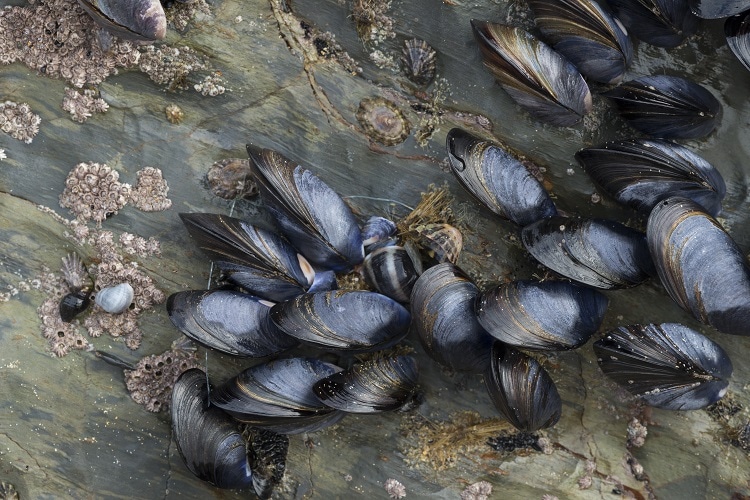Jul 11 2019

Image Credits: Mark Heighes/shutterstock.com
Researchers in China and the United States have reported in their study, published in Matter on July 10th, 2019, that mussels, which are notorious maritime stowaways recognized for the destruction of the boats’ hulls, find extensive engineering applications owing to their adhesive properties.
They propose that the chemical properties of mussel threads are inspiring engineering innovations that can focus a wide array of issues, from cleaning up oil spills to the treatment of polluted water.
Mussels have the ability to resist strong currents and waves by getting attached to rocks using clusters of thin, amazingly hard byssus threads. The adhesive strength of these threads arises from an amino acid group known as dihydroxyphenylalanine (DOPA), which adheres to the surface by carrying out a series of molecular gymnastics, including electrostatic and hydrophobic interactions and hydrogen bonds.
Researchers have discovered that not just DOPA is capable of sticking to all sorts of solid substrates by such interactions but also dopamine, a molecule with a structure similar to DOPA. The study revealed that dopamine’s ability to form a common coating on a broad range of substrates has stimulated the development of mussel-inspired chemistry as a robust new tool for environmental science and material surface engineering.
Mussels are broadly regarded as a nuisance in marine industries because they will colonize submerged surfaces. But from another point of view, the robust attachment of mussels on substrates under water has inspired a biomimetic strategy to realize strong adhesion between materials in water.
Hao-Cheng Yang, Researcher, School of Chemical Engineering and Technology, Sun Yat-sen University, China
Several mussel-inspired innovations are already in progress. A research team from China has designed a universal red blood cell, which can be accepted by people of all blood types, that functions by using mussel-inspired coatings to protect the cell from detection by the immune system of the body (and hence preventing the occurrence of harmful immune response).
Other studies have shown the successful development of superior materials that can separate oil and water, helping to reduce environmental damage to marine environments following oil spills. Different from some previously developed materials, scientists hope that these mussel-driven innovations could meet large-scale production.
Mussels have also led to progress in water purification technology. New materials that can eliminate organic pollutants, heavy metals, and pathogens from wastewater are being developed from polymerized dopamine, which can easily bind to these pollutants or to other materials with such adhesive properties.
On the other hand, even though the adhesive properties of mussels have attracted various recent research, still challenges should be overcome before applications in real life.
Researchers are still striving to gain comprehensive insights into the relationships between structure and property of mussel-inspired chemical compounds like polydopamine and to understand the complicated web of interactions between amino acids that affect their adhesive properties.
Despite simplicity and effectiveness, there are still some inherent limitations. Alkaline conditions are usually needed to realize the polymerization of dopamine, so it cannot be applied to materials that are unstable under alkaline conditions. Moreover, the deposition of PDA is a time-consuming process—it takes tens of hours to form a uniform coating on most material surfaces.
Hao-Cheng Yang, Researcher, School of Chemical Engineering and Technology, Sun Yat-sen University, China
It is hoped by some scientists that they can overcome these challenges by discovering safe, stable, and low-cost substitutes to polydopamine, like polyphenols.
This study was supported by the National Key Research and Development Program of China, the National Natural Science Foundation of China, the Nature Science Foundation of the Jiangxi Province, and the State Key Laboratory of Chemical Resource Engineering.
Research at Argonne National Laboratory was supported as part of the Advanced Materials for Energy-Water Systems Center, an Energy Frontier Research Center funded by the US Department of Energy, Office of Science, Basic Energy Sciences.